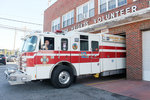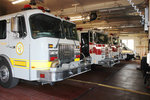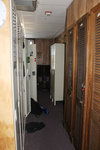 Severna Park
Severna ParkOvercast, 46°
Wind: 0.0 mph, N
 Severna Park
Severna Park





Lieutenant Todd Muir led a tour to show the deficiencies in the old station.
“This whole second floor, they had to have SERVPRO come in and rip all the ceiling tiles, all the insulation, everything, because there was mold up there,” he said.
The station is on a septic tank, so on busy weekends when the hall is being rented, waste will back up into the shower.
Volunteers have the use of lockers in a tight space, although some volunteers don’t have a locker.
The most problematic issue is the height and width of the engine bays.
“These were designed years ago when fire trucks weren’t as big as they are now, same with medic units,” Muir said. “When they purchase medic units, the one that comes to this station, they have to take the mirrors off and cut the posts down and put them back on, because they it just won’t fit in the building.”
Joe Angyelof, president of Earleigh Heights VFC, showed that there is no dryer next to the gear extractor, and there’s need for a decontamination room.
“The station is old,” Muir said. “We’re constantly putting Band-Aids on it.”
At Earleigh Heights Volunteer Fire Company, first responders aren’t just battling fires; they’re facing numerous threats to their health.
“The bricks are cracked outside and our station is about as cancer-growth as possible,” said Chief Dave Crawford. “The sleeping quarters are above the apparatus floor, and the tile is from 1957, so I’m sure it’s made of asbestos.
“We’re asking [the firefighters] to do a dangerous job while living in a dangerous environment.”
The crew at Earleigh Heights — dozens of volunteers along with four 24/7 career staff and one lieutenant — say the station is too old to be renovated, so it needs to be replaced. No one disagrees with that assessment, but the Severna Park community is divided on how to pay for the $6 million replacement building and where to put it.
Chief Dave Crawford wants Earleigh Heights to build and lease three pad sites to businesses. Those profits would allow them to build a new Earleigh Heights station 600 feet to the east, downhill by the post office. About 4.5 to 5 acres would remain as open space.
Crawford said EHVFC raises about $350,000 a year and it spends $300,000 for operating costs. “That doesn’t count apparatus and equipment,” he said.
The county contributes $57,300 a year, he said.
That plan requires the fire company to get the zoning changed from residential to commercial. Magothy River Association President Paul Spadaro thinks that’s a bad idea because of drainage into Cattail Creek and the precedent that would be set by a zoning change.
“Our opposition is to the spot zoning, which is something the MRA has always opposed,” Spadaro said. “The MRA opposed Beechwood Park’s liquor license in 1957 because it said spot zoning. If we allow spot zoning to go in, it’s going to be a domino effect. People don’t want Route 2 to look like Rockville Pike or Mountain Road and be commercialized all the way down.”
Crawford said the volunteers have paid for traffic studies.
“When Harris Teeter went in, there was a 10 to 11% increase in traffic around that intersection,” he said. “There’s no way with three pad sites there will be another 10 to 11% increase.”
After having an initial request denied by the Office of Planning and Zoning in early 2019, EHVFC took its case before the Board of Appeals on September 11. The board dismissed the case, so members of Earleigh Heights must now take their argument to circuit court or wait for the comprehensive rezoning process, which will take place following the adoption of the next General Development Plan in 2020.
It’s an unwelcome delay to Crawford. “Construction costs go up eight to 10% each year, and those costs are coming out of my pocket, not the county’s,” Crawford said.
The volunteers could lobby the Anne Arundel County government for a new station. Crawford doesn’t see that as a viable possibility.
“When the county makes a decision like that, you start losing volunteers because there’s no ownership of the building,” Crawford said. “The volunteers lose their independence. It’s as much about their pride as anything.”
Spadaro acknowledges the need for the new station but doesn’t like the way Earleigh Heights personnel are handling the matter.
“It becomes an issue where they don’t want to give up their independence, but it’s holding everybody hostage,” Spadaro said.
Crawford sees the issue as a bunch of volunteers trying to do what the EHVFC has done for a century: serve the people of Anne Arundel County.
“I was raised to give back,” Crawford said. “This is something I enjoy and it’s a vital service. To me, the volunteer fire company is part of the fabric of the community.”
To make his case, he cited several figures prepared by the Anne Arundel County Volunteer Firefighters Association.
When accounting for more than $31 million in volunteer-owned apparatus, $77 million in volunteer-owned stations and $3.5 million in volunteered hours, the volunteer fire services in Anne Arundel County save taxpayers $111 million annually.
“If all the volunteers said today, ‘You’re on your own,’ [the citizens] have to come up with $111 million,” Crawford said. “But our point isn’t to throw stones at anyone. We all have to work together.”
Crawford has met with nearby community associations to allay their fears and find an agreeable solution. For example, after initially asking the county to rezone the property to C3, he changed the request to C1 because it would allow less commercial development.
EHVFC holds meetings on the first and third Thursday of each month at 8:00pm. Crawford encourages people to attend a meeting or contact him at dcra2@att.net if they have concerns.
Other items that may interest you
Comments
No comments on this item Please log in to comment by clicking here